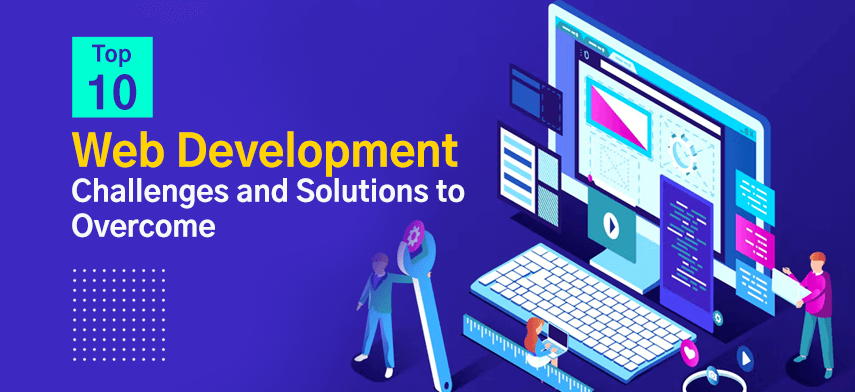The web development landscape is continuously evolving to satisfy the ever-changing market demands. Business owners are now creating value-driven solutions that generate positive experiences. However, we cannot deny the fact that ensuring top-notch quality across user interactions is not an easy task.

Every unique project has a certain set of challenges that you need to tackle to achieve the desired results. Understanding them can help your company thrive. Our today’s post will give you detailed information about common web development challenges and roll out real-world solutions to benefit from.
Major Web Development Challenges and Solutions
Our experts have come up with this compilation of challenges in web development and practical solutions to combat them that can help your company make better decisions in accordance with your project needs. The list is not limited to but includes the following:
#1 Web Development Process
Curating a consistent and easily maintainable web development process is one of the biggest challenges that businesses face. Some companies are unable to follow a standard roadmap and end up making losses. They often experiment with different approaches, which can meet their requirements for the short term but are bound to introduce unpredictable vulnerabilities in the future. This increases the time-to-market and makes maintenance activities more complex and time-consuming.
Many companies focus on micromanagement rather than optimizing their development stages. They make undefined strategies to accelerate the process but fail to notice its negative impact. This leads to many web development problems that need regular pivoting and iteration.
Solutions
- Proven Methodologies: As a business owner, you need to exploit popular software development methodologies like Agile, Scrum, XP, etc. This will help your team work in small sprints and complete delegated tasks within set timelines. Besides, viewing project progress in real-time also becomes easy.
- Adopting DevOps: DevOps enhances collaboration across different teams and aspects of the entire project life cycle, including testing and QA, development, and operations. You can take advantage of DevOps automation services offered by top software development companies to decrease the rate of failures for new releases, reduce the lead time between fixes, and improve the time-to-market.
- Outsourcing IT Resources: Hire dedicated developers that are relevant to your project. These developers have expertise and experience in planning, executing, and optimizing web development roadmap. They have a clear idea about specific implementations and their resulting outcomes. This can speed up your web development process, enhance collaboration, and help you make your project live quickly.
- Standardization: Follow a standard process that focuses on consistency and continuous improvement. This process should be easy to understand, predict, and maintain. All the developers should work in unison to fulfill different requirements but with a solo approach.
#2 Talent Gap
Our list of web development challenges would be incomplete without mentioning the talent gap. Having a robust web development team is really crucial for the success of your project. But companies often find it difficult to choose the right one. Either they are skeptical about their choice or unable to onboard the talent relevant to their business needs. This confusion leads to hiring incompetent developers who are unable to produce quality deliverables as and when required.
Let’s say your deadline to build a real-time chat app is near, but your in-house team lacks the needed capabilities to achieve it within a set timeframe. In such a case, you would think of hiring some more developers. Right? But how will you identify the candidates that are a perfect fit for the project? Below is the solution.
Solutions
- Choose Reliable Approach to Hiring: You can either hire developers from popular job boards like LinkedIn, Indeed, Monster, etc., or choose freelancers from websites like Freelancer, Upwork, and Fiverr. However, the most competent way is to outsource your requirements to the right company. You can also opt for a team augmentation service model to overcome skill deficits.
- Go for Experience-based Hiring: Choose developers with solid industry experience. Ask them to share their portfolio and previous work samples to identify whether their experience is relevant to your project. Check the list of clients they have served to understand their market reputation.
- Go for Skill-based Hiring: Hire developers with strong technical expertise. They should be skilled enough to deliver solutions for different use cases. Understand their approach to keeping up with the latest technology trends and advancements.
#3 Tech Stack
A technology stack is a series of tools that are necessary to design and develop a web application. These tools include web-based technologies, independent applications, platforms, servers, frameworks, APIs, IDEs, SDKs, programming languages, and more. Your chosen tech stack will directly impact your business outcomes. It may either help your project succeed or bring it close enough to a breakpoint.
There are various tools and technologies available that developers can use. However, this overwhelming number of options makes it difficult for developers and business owners to pick the right ones. Many times, they make wrong choices that later result in big technology glitches.
Solutions
- Be Clear with Your Project Requirements: Define your project requirements beforehand. You need to have a crystal clear idea of the type of product you want to build, the target audience and pain points to be addressed, the objective and project complexity, set timeline, features, functionalities, and overall budget.
- Finalize Features and Functionalities: You can easily overcome such web developer challenges by making a list of features and functionalities to add. Make sure you concentrate on integrating the ones that will add value to your application and then finalize the right tech stacks.
- Tech Stack Structure: You should have a good understanding of the structure of your tech stack, which consists of two significant parts known as client-side and server-side (frontend and backend). This will help you choose the tools wisely.
- Emerging Technologies: You need to know the importance of the popular technologies in use and how they can uplift your project outcomes. You should always keep an eye out for updates, new releases, and modifications for the same.
#4 Browser and Platform Compatibility
It is one of the key web application development issues that are tough to address. But ensuring that your application is up and running on all the preferred browsers, platforms, and multiple screen sizes is a must. These issues become more complex as legacy browsers cannot offer the needed support for modern layouts, features, and security measures. Besides, making an app that is compatible with various OSs and devices is not easy.
Solutions
- Testing: Perform proper testing (manual and automated) for your web app. Define a doctype, use a CSS reset, verify support for CSS properties, focus on fallback solutions, and exploit cloud-based browser testing to ensure cross-browser compatibility. Develop the habit of using simulators or real devices to analyze the performance under platform-specific situations.
- Coding: Validate your code and avoid writing browser-specific native code. Use platform-agnostic tools that facilitate code reusability. Utilize frameworks and libraries such as Flutter, React Native, Xamarin, Ionic, etc., to build cross-platform or hybrid applications. You can follow these best practices to ensure that your code is compatible with modern platforms and devices.
#5 UI/UX
Delivering engaging user experiences is not an easy job. It is one of the top web design challenges developers have been facing for years now. It is all about improving interactivity and providing simple yet effective interfaces that create a long-lasting relationship with your target audience. It is imperative to prioritize a visual appeal that connects with your user base in a hassle-free way. The goal is to make the app easily accessible and usable.
From integrating the things that appear on screens of your web app to everything that the end-users click, developers need to make sure that the designs are flexible and the UX content is readily available at each step.
Solutions
- User Personas: You need to create user-centric designs with the help of online surveys and guerilla research. You should have a clear understanding of different user aspects like user touchpoints, problems faced by users, location, gender, devices used, age, interests, preferences, etc.
- Interoperability: Developers can focus on making interactions interoperable where the exchange of data is easy and maintainable. They should create design patterns that can handle multiple user requests seamlessly.
- Navigation: All the built-in features and functionalities should support smooth navigation. Developers need to ensure that the users get all the necessary information and assistance to use the app. Full-screen navigation, card-style design, and keeping frequently-used actions at the bottom of the screen are some imperatives to consider.
- Typography: Designs should render easy-to-read and understandable content throughout the user journey. The style and appearance of the text should follow a certain hierarchy driven by color scheme, layout, grid, spacing, and line lengths.
- A/B Testing: Developers can build alternate designs and patterns to compare and conclude which ones can prove beneficial. They can use popular frameworks like Angular and React that offer an array of ready-to-use material components to develop parallel UIs.

#6 Performance and Speed
These are significant challenges in web application design and development that businesses face. No user likes delayed processes, slow-loading apps, or other lagging issues. But it is difficult to offer consistent and stable performance throughout the entire app interaction. Additionally, keeping a check on this performance is full of complexities.
Regularly occurring speed and performance issues can negatively affect your search engine rankings. It may lead to poor user experiences that can lead to low conversion and impact user retention.
Solutions
- Web App Metrics: Ensure that you track essential KPIs and user metrics such as app installs/uninstalls, growth rate, mobile downloads, app crashes, upgrades, Lifetime Value (LTV), and cohort analysis to improve performance.
- Tools: Leverage app analytics tools and technologies like Google Analytics, App Store Connect, Flurry, Mix Panel, Localytics, Firebase, UXCam, Adjust, etc., to track the above metrics and improve performance and speed.
- Google Core Web Vitals: You need to strongly follow Google’s Web Vitals. Focus on metrics like Your Largest Contentful Paint (LCP), First Input Delay (FID), and the Cumulative Layout Shift (CLS) of your pages.
- Optimization: You need to reduce app size and use Content Delivery Network (CDN). You should avoid using third-party sources and focus on using the Application Performance Monitoring (APM) System. Besides, optimizing images, code, and other content is also necessary.
#7 Scalability
When it comes to web development, scalability is of utmost importance. It helps exploit the web assets to expand or contract the system capacity. It helps businesses to interact with users while simultaneously acquiring new ones. That’s why many companies strategize to use their bandwidth and systems properly. However, this decision cannot help them in achieving the desired scalability.
Because scalability is not about the system performance or its bandwidth; instead, it stands among the web development challenges that require balancing the load on the server. So, when the traffic increases, you need to add more servers to maintain the balance. This means that your app should have the ability to cater to the requirements of many users at the same time.
Solutions
- Cloud Computing: Your company should utilize cloud computing (Vertical and Horizontal scaling) capabilities. It can explore popular cloud platforms and solutions such as Amazon Web Services (AWS), Google Cloud Platform, Microsoft Azure, DigitalOcean, IBM Cloud, etc., to manage increasing load effortlessly.
- Microservices and other Distributed Systems Architectures: When conventional n-tier architecture is not enough for your scalability needs, one needs to utilize distributed systems such as Microservices, distributed caching solutions, and sharded databases architecture. These technologies should help you to scale to hundreds of millions of users.
#8 Security
Managing security is among the considerable software development challenges driven by the increasing number of cyberattacks. These cyberattacks are security misconfiguration, cross-site scripting, broken authentication & access control, injection, XML external entities, and more. Companies find it difficult to address these attacks that later lead to data malfunction, poor user authorization, phishing, and other app vulnerabilities.
If your application deals with critical user information like payment details, contact, or confidential documents, then these issues can cause more harm than you can ever imagine. That’s why it is necessary to closely monitor your app security and make it a continuous process.
Solutions
- SSL Certificates: To ensure secure, confidential information exchange between clients and servers, you need to back up your web app with SSL certificates (HTTP over SSL). This way, both the server and the client encrypt data before transmitting, then decrypt it upon receipt.
- Hosting: You need to choose a secure web host. This host should provide Secure File Transfer Protocol (SFTP), file backup to a remote server, and regular security upgrades alongside using Rootkit Scanner.
- Validation: You need to validate user input and ensure it falls within the expected characters. You can easily sanitize and eliminate unwanted characters by escaping, replacing, removing, or encoding characters.
- Authentication: Your company should follow a good password policy. Along with biometrics as well as certificates and token-based policy, it should opt for two-factor and multi-factor authentication.
- Accessibility:
When it comes to accessibility, always follow the Principle of Least Privilege (PoLP). To put it simply, give access to only the necessary data, tools, and resources to avoid any security breach or misconfiguration.
Some other ways to consider are exceptions and container management, using the secrets mechanism in Docker or Kubernetes, testing (static, dynamic, and penetration), and Extended Detection and Response (XDR) solutions.
#9 Third-party Integrations
Third-party integrations are not limited to payment gateways. Several functionalities can be added to your application through these integrations. For instance, you need Google Maps API integration to access maps from your app. Third-party integrations can also help you enhance social media capabilities and implement dedicated multi-language support. What makes them one of the most important web application development challenges to overcome is their secure integrations with app customizations.
In the case of outdated APIs, they become an immediate threat that acts as a loophole to unforeseen issues. Moreover, there are a few technical differences between web apps and third-party services, which can be easily resolved with customized APIs. But if your app is based on a monolithic architecture, this process becomes too complex.
Solutions
The best solution to address this challenge is to ensure that the changes made by third-party service providers reflect in your app architecture. You should employ QA teams to monitor these services and gain all the required information about the changes in the architecture or the API code.
To achieve secure integrations and uninterrupted performance, you need to make sure that your app architecture is in sync with your API code. Here, maintenance of the code and regular updates can uplift the production alongside reducing the cost of development.
#10 Support and Maintenance
The real technical challenges in software development begin just after your web app is live. Yes, we are talking about post-launch support and maintenance activities. Poor execution of these activities can lead to several issues like unresponsive web pages, performance issues, slow loading, etc. You will face other problems if you want to update the legacy APIs or upgrade the entire application for security purposes. During such maintenance activities, ensuring zero downtime becomes even more difficult. There are various dependencies that can lead to downtime.
Solutions
- Monitoring: If you want to support your maintenance activities, monitoring your app is a must. You need to closely observe the essential aspects of your app to plan effective remediation. This will help you predict turbulent circumstances and plan immediate bug fixes as and when required.
- Microservices: You need to have a web architecture with minimal dependencies in place to experience higher uptime while updating your app. And microservices architecture can help you do that. It is a comprehensive suite of services that upgrades without causing any harm to your existing system. This means that no function is disturbed or affected during the upgrade.
- Future-proofing: Create applications that can meet your existing and upcoming requirements with ease. You need to concentrate on making an app that can support more users than expected. It should easily switch servers and databases. It should also have the flexibility to accept new features and functionalities.
Conclusion
With all the above, you would have surely understood that web development is not just about creating websites. It outlines the development of complex applications, web services, and many other digital products, bringing their own challenges to the table. We have covered the major web development challenges that businesses face in today’s digital age. If you are experiencing some other issues and want dedicated professionals to resolve them without compromising on quality, you can outsource your requirements to Mobisoft Infotech and future-proof your project right away.

Author's Bio:

Pritam Barhate, with an experience of 14+ years in technology, heads Technology Innovation at Mobisoft Infotech. He has a rich experience in design and development. He has been a consultant for a variety of industries and startups. At Mobisoft Infotech, he primarily focuses on technology resources and develops the most advanced solutions.









